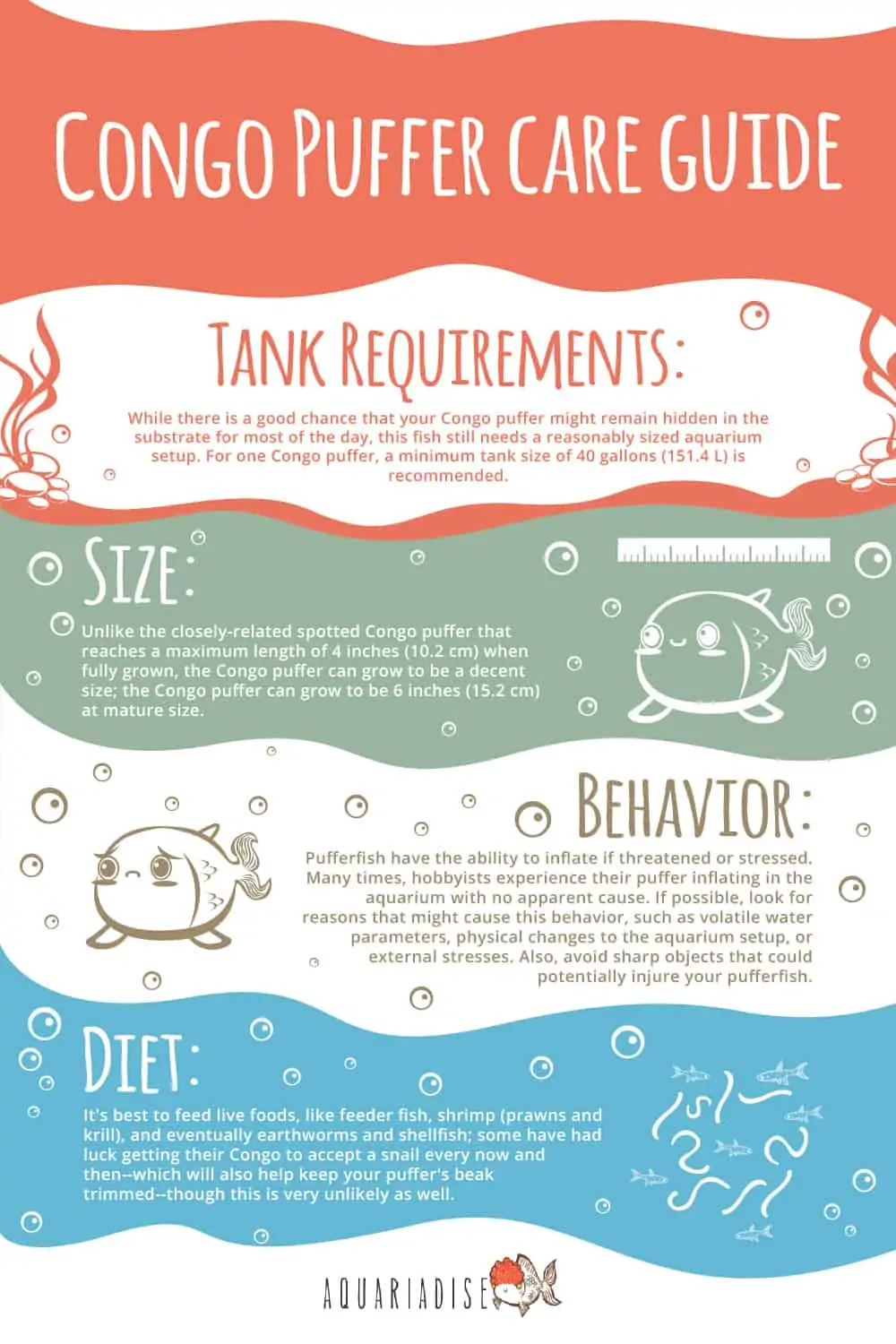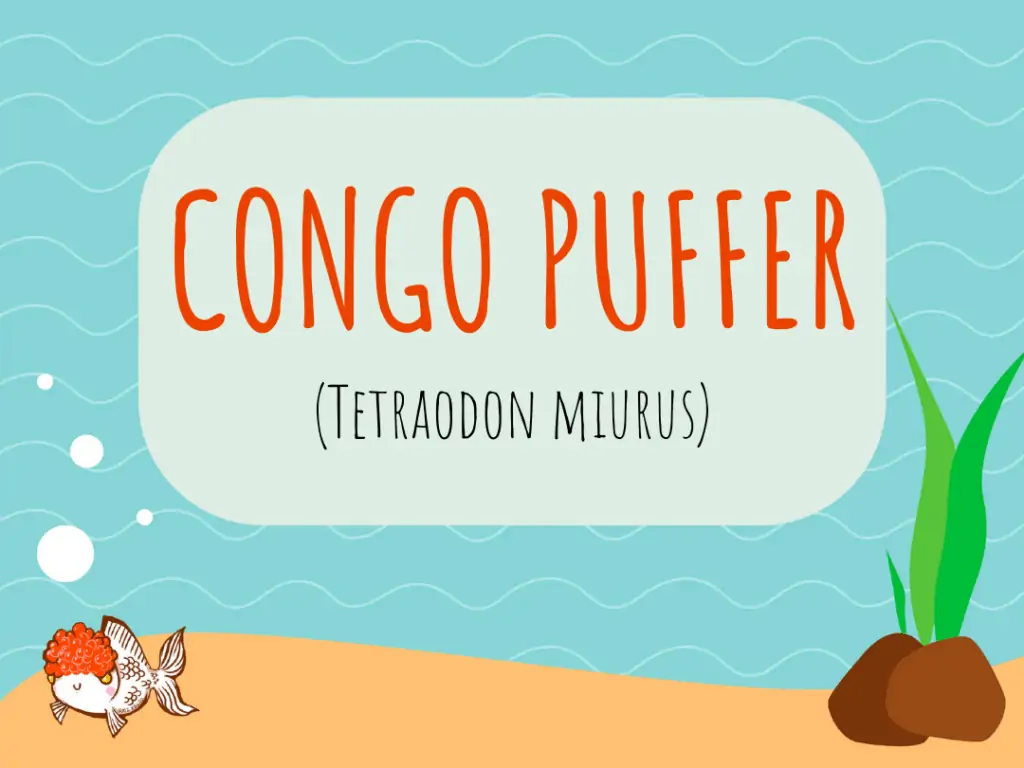Most pufferfish are known for their bold personalities and beautiful colorations. The Congo puffer is no exception and is becoming an increasingly popular species within the freshwater aquarium hobby. Like other pufferfish, the Congo puffer does best in a tank by itself; this can be boring for some hobbyists, but any puffer-keeper knows that these fish can quickly fill up a display!
Keep reading to find out everything you need to know about Congo puffer care and how these fish might be a little more challenging than other related species!

Name
Tetraodon miurus is commonly known as the Congo puffer and the potato puffer. As we’ll discuss later, these fish originate from the Congo region and tend to resemble the vegetable of the same name.
As a species of puffer, these fish are able to inflate their stomachs with air or water in defense to predators. As a member of the Tetraodon genus, this also means that they carry the deadly neurotoxin, tetrodoxin. However, this poison can only enter the bloodstream if the fish is ingested and serves little to no threat when handled and/or prepared correctly.
It is important to note that another similar species named the spotted Congo puffer (Tetraodon schoutedeni) is not the same as the Congo puffer (Tetraodon miurus) discussed in this article. While these two fish are in the same genus and originate from the same regions of Africa, they are recognized as two separate puffer species.
Natural habitat
As its common name suggests, the Congo puffer is from the Republic of Congo and the Democratic Republic of Congo in Central Africa. These fish can be found in rivers of all sizes, even those with considerable flow and rapids. Most of the time, these fish will be buried in the soft substrate waiting to ambush passing prey.
Identification
The Congo puffer may be difficult to identify at first because it has the ability to change colors based on its surroundings, much like a chameleon. Most often, these fish display natural tones of greens and browns in order to blend in with the substrate, rocks, and fallen trees and vegetation. However, they have also been known to show deep reds and oranges and various patterns depending on their current demeanor.
One interesting anatomical adaptation of these fish is their upward-pointing mouths. As mentioned before, these fish like to hide in the sandy substrates of fast-flowing rivers waiting for smaller fish and invertebrates to pass by. An upward-pointing mouth allows the fish to easily suck up prey without having to expose itself beforehand.
The dorsal fin is also very close to the caudal fin and can lay flat against the back for extra concealment.
How big do Congo puffers get?
Unlike the closely-related spotted Congo puffer that reaches a maximum length of 4 inches (10.2 cm) when fully grown, the Congo puffer can grow to be a decent size; the Congo puffer can grow to be 6 inches (15.2 cm) at mature size.
While this might not seem like a lot at first, you will need to consider substrate depth as well as tank size and tank mates.
Congo puffer tank requirements
While there is a good chance that your Congo puffer might remain hidden in the substrate for most of the day, this fish still needs a reasonably sized aquarium setup. For one Congo puffer, a minimum tank size of 40 gallons (151.4 L) is recommended.
In order to best replicate their natural conditions in the wild, a sandy substrate, rock cave formations, and cured driftwood will greatly be appreciated by your pufferfish; hardy, fast-growing plants may be added, though are not necessary.
One of the most important aspects of setting up a good Congo pufferfish aquarium is the substrate. The Congo puffer is an ambush predator that relies on the substrate to conceal itself from prey. This means that the substrate should be at least 3-5 inches (7.6-12.7 cm) deep throughout the aquarium so that your puffer can bury itself.
The problem that comes along with a deep sandbed, however, is the waste and debris that gets caught. Tank maintenance is especially important with puffers as they are messy eaters, which can affect water parameters over time. Good filtration, regular water changes, and substrate vacuuming are necessary for keeping your Congo puffer happy and healthy.
Otherwise, Congo puffers do well in typical tropical water conditions. Water temperature should remain constant between 75-82° F (23.8-27.8° C) with a relatively neutral pH between 6.5-7.8.
Congo puffer tank mates
Congo pufferfish are predatory fish. They have a sharp beak that acts as teeth that helps tear meat and cut through hard shells.
Because of this, Congo pufferfish tank mate compatibility is near zero; while there’s always the possibility that your fish won’t eat other larger fish that you introduce into the aquarium, it’s always better to be safe than sorry and give this puffer a tank to itself!
Can you have two puffers in one tank?
Some species of pufferfish, like pea puffers (Carinotetraodon travancoricus), may be able to be kept together in groups, but the Congo puffer cannot. These fish set up territories and will attack and/or eat anything that comes within those boundaries.
Congo puffer behavior
Pufferfish have the ability to inflate if threatened or stressed. Many times, hobbyists experience their puffer inflating in the aquarium with no apparent cause. If possible, look for reasons that might cause this behavior, such as volatile water parameters, physical changes to the aquarium setup, or external stresses. Also, avoid sharp objects that could potentially injure your pufferfish.
For the most part, your Congo puffer will stay buried in the sand or hidden under rocks. However, one of the best parts of pufferfish is their bold personalities and unique hunting styles!
Are pufferfish good pets?
Pufferfish are adored by hobbyists because there isn’t another fish species quite like them. While each fish might have its own character, pufferfish have their own personality that can fill up a large tank!
One of the best things about having a puffer is feeding times; usually, these fish need to be fed live food which gives an opportunity to get a glimpse of their natural behaviors while in captivity. Some hobbyists have found that their puffers recognize their owners and might be a little more active when they’re around as they’re anticipating food!
While Congo puffer diet might be specific, the display is definitely worth it.
Congo puffer diet
The Congo puffer is mainly a piscivore. This means that their diet largely revolves around consuming other fish. Because of this specific diet, Congo puffer care might be slightly more challenging than other freshwater fish and some species of puffer.
On top of this, Congo puffers might reject any food that isn’t alive. Some hobbyists have had luck transitioning their Congo onto frozen foods, though this will take time and effort.
Otherwise, it’s best to feed live foods, like feeder fish, shrimp (prawns and krill), and eventually earthworms and shellfish; some have had luck getting their Congo to accept a snail every now and then–which will also help keep your puffer’s beak trimmed–though this is very unlikely as well.
Remember to always get food from a reputable source in order to guarantee the best nutrition and to keep your fish parasite-free. In order to have complete control over the diet of your fish and to always have food available, it’s recommended to set up a separate breeding tank for such purposes.
Breeding Congo puffers
Due to the aggression and space requirements of the Congo puffer, breeding in captivity has not yet been achieved. Placing two puffers in the same aquarium can quickly result in death and should never be tried unless a pufferfish expert!
Conclusion
The Congo puffer isn’t the most popular species of pufferfish in the hobby just yet, but its bold personality, chameleon colors, and interesting hunting behaviors make it one of the more desirable types of puffer to have. These fish can be slightly more difficult than other freshwater puffer species as they need a larger tank to themselves and rely on a live diet of fish and invertebrates. However, if you have the room and ability to commit to a specific diet, then the Congo puffer could be for you!
If you have any questions about Congo pufferfish, other types of freshwater puffer, or have had experience caring for one of these apex predators, don’t hesitate to leave a comment below!



I keep a red congo puffer,
He or she lives in a 55 gallon tank with a sand substrate a large log a few nice big rocks and a bunch of live plants. My filter is a aquaclear 110 and I find it to be perfect for the job. I also have 2 power heads that each move 500 gph. I feed my congo a variety of different foods, it likes gold fish (comets) or minnows, it also eats earth worms, shrimp, crabs and the occasional snail. I can speak from experience that these fish are extremely aggressive and when they’re not buried in the sand waiting for a un-expecting fish to swim by he is out patrolling his tank back and forth swimming in the current. Over all its a blast keeping this fish but I do often wish I could keep other fish with it because when he is buried in the sand it looks like a unstocked tank.